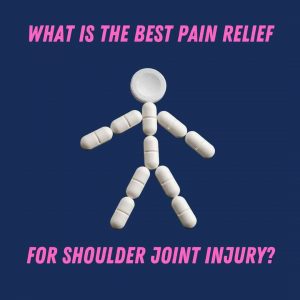Shoulder pain remedies

Shoulder joint pain can occur due to a number of conditions including rotator cuff tendon issues, a dislocated shoulder, a frozen shoulder or shoulder impingement, and fractures, to name a few.
If you’re suffering with a shoulder problem, it can be difficult to know what you should do about it. Some shoulder pain improves with simple rest, other types of pain will improve with physiotherapy, while continued pain after 3-6 months of non-operative treatment, could be a sign that you may benefit from shoulder surgery.
Often controlling pain early and treating the cause can prevent patients from developing chronic pain which can be more difficult to treat.
What self-management is there for shoulder joint pain?
If you have developed shoulder pain triggered by an activity, be it work, sport, or exercise, the first step would be to try to avoid that aggravating activity to allow the pain to settle.
It is important to emphasise that activity modification/avoidance does not mean stopping all shoulder movements. Stopping all shoulder movements due to pain can quickly lead to joint stiffness. We recommend gentle movements to keep the joint mobile, while avoiding activities that make your pain worse.
If you are resting your shoulder after an injury or a bout of shoulder pain, you should avoid heavy lifting, repetitive activities, or loading the shoulder. Maintaining good shoulder posture when sitting or standing by keeping your back straight with shoulder blades down and back and arms in neutral position, is also important.
The goals of managing shoulder pain are reducing pain and swelling, keeping the joint mobile, and rehabilitating the joint once pain is settled by improving strength and range of motion.
Will heat or cold help?
Many patients seem to struggle with the decision of whether heat treatment or cold treatment is better for their shoulder pain. My rule of thumb is that if pain is due to inflammation, then cold works better while if pain is due to muscle spasm, warm seems to do the trick.
Heat therapy can often relax tense muscles and help you to move your shoulder a bit more when muscle spams kick in. Warm compresses, and hot water bottles can be quite effective in muscle relaxation, however another trick is to use warm water to relax your shoulder muscles as you gently move the shoulder while having a shower. It is important that whatever heat treatment you use, you should avoid excessive heat as this can cause scalds or burns.
Cold treatment can be great in helping pain from inflammation after an injury, surgery, or in inflammatory conditions such as frozen shoulder or bursitis. If you don’t have an ice pack, you can use ice, or a bag of peas wrapped in a towel (do not apply directly to the skin) and apply it over the shoulder for about 20 minutes at a time. We recommend using cold treatment between painkiller doses and just before bed to help you manage inflammatory shoulder pain. We can recommend a good ice pack that can strap on to the shoulder here (paid link).
What painkillers are good for shoulder pain?
Early on in shoulder pain, if the pain is not severe, simple over the counter painkillers would usually suffice. They can be used in combination with hot or cold treatment. It is important that any medication is taken as advised and if you have other medical problems you should discuss with your doctor whether painkillers can interact with any of your regular medicines.
Paracetamol is a simple over the counter painkiller that has few side effects and doesn’t interact with many other medications. For it to be effective it needs to be taken regularly (usually 4 times per day).
If the pain is due to inflammation, then an anti-inflammatory such as Ibuprofen can be useful in helping to reduce pain and swelling. On its own an anti-inflammatory is not a great painkiller. Anti-inflammatories can interact with some other medications, they can cause heartburn or stomach ulcers if taken on an empty stomach, and they can cause kidney damage with prolonged use, so I do not recommend using prolonged courses (more than 2 weeks) of anti-inflammatories.
Other over the counter painkillers include topical anti-inflammatory gels. Most patients with shoulder pain that I see don’t seem to get much benefit from topical gels and I think this is because the shoulder is a deep joint surrounded by large muscles such as the deltoid muscle.
If simple over the counter painkillers do not work, then prescription drugs may be necessary to help with shoulder pain. Our next go-to drug would be Co-codamol.
Co-codamol is a combination of codeine and paracetamol. You cannot take co-codamol with paracetamol or this can cause a paracetamol overdose. Co-codamol is a good painkiller for shoulder pain, but its side effects include drowsiness and constipation. We usually prescribe other medications to prevent the constipation. If drowsiness is a major problem, co-codamol can be used at night to help with sleep while using paracetamol only in the day. Codeine is an opiate drug so there is a risk of addiction, but we do not prescribe this drug for long periods so haven’t seen addiction as a problem
Another useful prescription painkiller is Diclofenac which is a stronger anti-inflammatory than Ibuprofen, but we try to limit its use to less than two weeks due to the risk of stomach ulcers and kidney damage.
It is very rare that we use strong opiate drugs such as Tramadol or Morphine for shoulder joint pain and we try to avoid these as much as possible due to significant side effects and risk of addiction.
When taking painkillers, it is important to take them regularly as advised, plan to take them at least half an hour to an hour before any physiotherapy exercises, and half an hour to an hour before bedtime to help you sleep better. You can find more tips for sleeping with shoulder pain here.
What painkillers do you use for nerve pain?
Pain in the shoulder region can be due to a neck problem, a shoulder problem, or both. You can read our blog about how to determine if your shoulder pain is due to a neck problem here. If the problem is in the neck, it is usually due to neve irritation. Nerve pain, often called neuropathic pain, or radiculopathy (pain from a “trapped nerve” in the spine), can be difficult to control. Patients often find conventional painkillers ineffective. There are special medications used for nerve pain. The drugs modulate how the brain perceives pain. They can take some time to build up in the system to be effective and can need to be adjusted up or down to avoid side effects. We don’t prescribe neuropathic painkillers ourselves; we usually refer patients to a neurologist or chronic pain specialist to help with prescribing, and GPs usually help with the adjusting of these drugs to minimise side effects.
What is the non-operative treatment for shoulder pain?
Many causes of shoulder pain benefit from physiotherapy to stretch out tight tissue, improve posture and strengthen weak shoulder muscles. If you would like us to recommend a good physiotherapist, please get in touch.
In cases of significant joint pain due to inflammation such as frozen shoulder, calcific tendonitis, or subacromial shoulder pain, a steroid injection to the shoulder may be useful to control the pain. In most cases a steroid injection needs to be followed by exercises or physiotherapy to prevent the pain from recurring. Getting a steroid injection in early can reduce the need for other painkillers and prevent chronic pain from becoming a problem.
How do you treat shoulder joint pain with surgery?
If non-surgical treatments haven’t worked to relieve your pain and restore your movement, sometimes it’s necessary to treat shoulder pain with surgery. Surgery is decided on a case-by-case basis, taking into consideration the cause for your shoulder joint pain, your medical and drug history, investigations, and your response to non-operative treatment.
There are two main types of shoulder surgery:
- Open surgery – a large incision is made in your shoulder
- Arthroscopic surgery– a type of keyhole surgery that uses a camera to look inside your shoulder joint and carry out treatment through small incisions
Surgery for frozen shoulder includes a capsular release, which is an alternative procedure to manipulation and is a type of keyhole, or minimally invasive surgery.
Surgery for a rotator cuff tear, involves repairing the damaged tendons, clearing out inflamed tissue, and sometimes shaving off bony prominences so the repaired tendons can glide without disruption.
Surgery for shoulder dislocation, depends on the type of instability you have. It may involve key-hole surgery to repair loose labrum and ligaments, or open surgery to replace bone loss to the socket.




